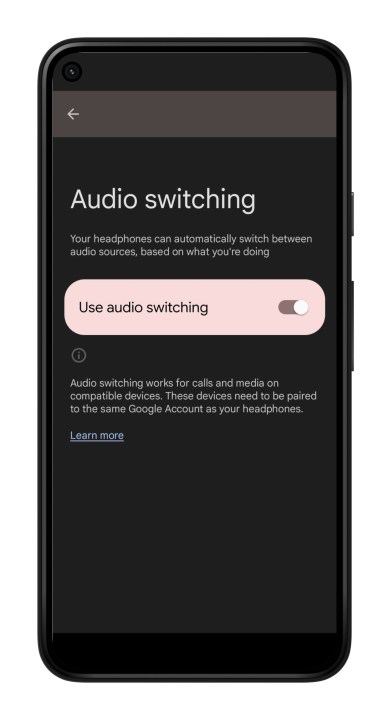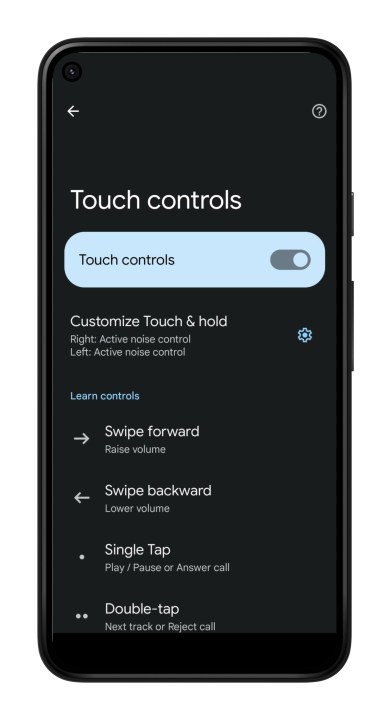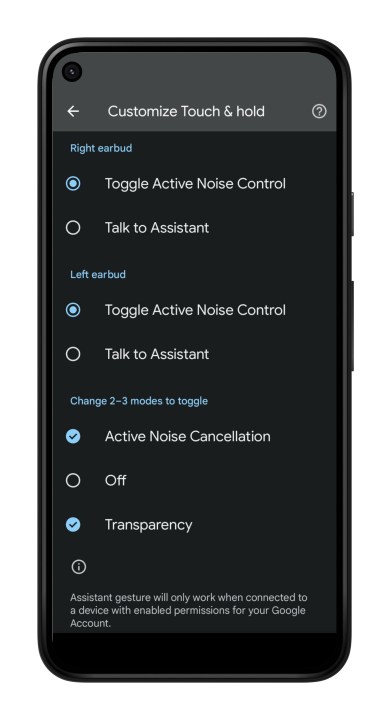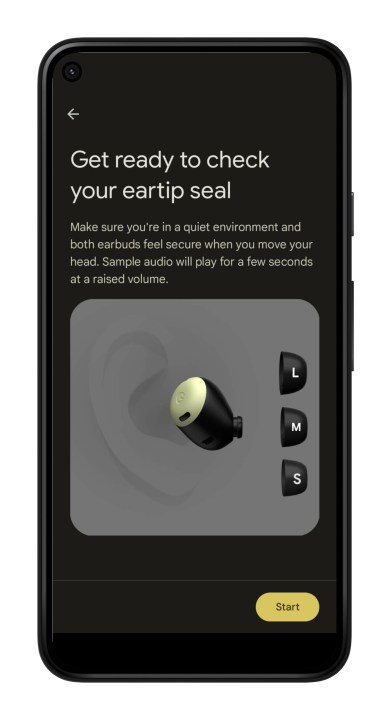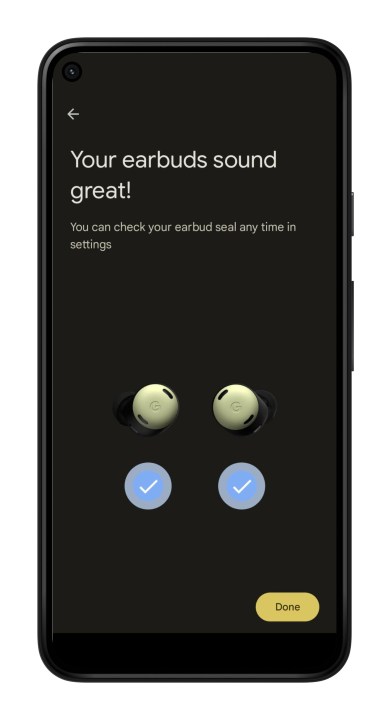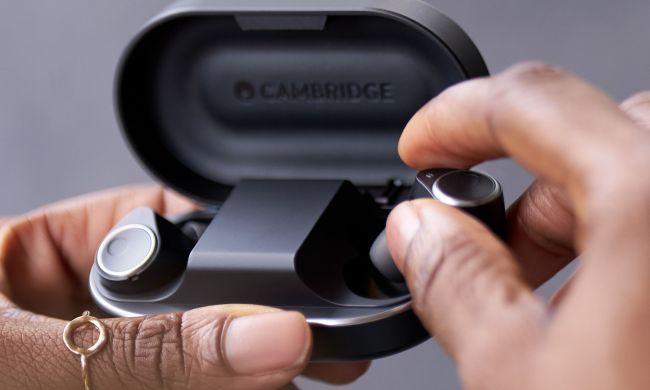- Compact and comfy
- Very good sound quality
- Very effective ANC/transparency
- Wireless charging
- Bluetooth Multipoint
- No real EQ adjustments
- No high-quality/low-latency codecs
- Still no iOS Pixel Buds app
Maybe it’s not fair to always view Google and Apple as locked into some kind of gadget death-match. But when it comes to wireless earbuds, comparisons are inevitable. And let’s face it: Google has struggled to create a version of its Pixel Buds that can go toe-to-toe with Apple’s AirPods Pro.
But that struggle is over. Google’s new Pixel Buds Pro are stylish, comfortable, and packed with the kind of features Android fans have been asking for — the biggest addition being active noise cancellation (ANC).
Just how good are they at $200? And do they deserve a spot among the best wireless earbuds? Let’s check ’em out.
What’s in the box?
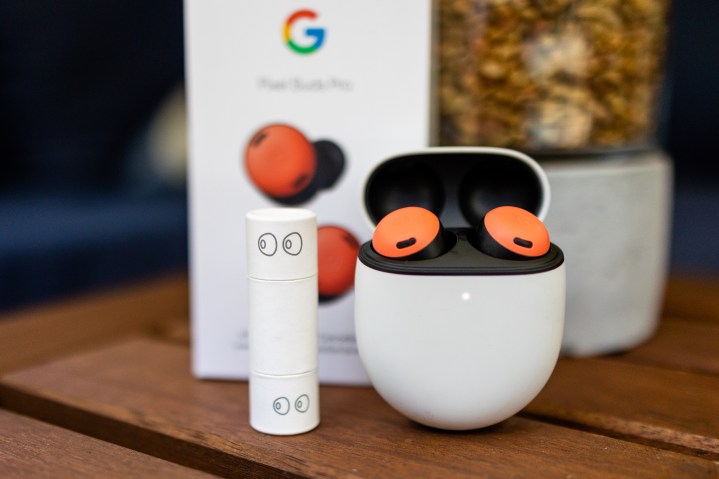
Hardly anything. You get the Pixel Buds Pro, already housed in their charging case, a clever little cardboard tube containing two extra sizes of silicone eartips (you get three in total), and a printed quick-start guide. Expecting a charging cable? So was I, but the Pixel Buds Pro are the first wireless earbuds I’ve encountered that don’t ship with one. Given that it’s usually Apple that likes to ditch hardware before people are really ready for them to do so, this was a surprise.
On the other hand, you can charge the case wirelessly. And there’s also a pretty good chance that if you’re buying Pixel Buds Pro you already have a phone that uses USB-C. So there’s that.
Design

Viewed from the outside of the Buds Pro’s case, it doesn’t look like much has changed since the now-discontinued second-gen Pixel Buds, or their cheaper replacements, the $100 Pixel Buds A-Series. It’s the same matte-finish egg-like container with an angled flip-top lid. (And it’ll pick up the same marring that all things matte tend to pick up.) Look closely and you can see it’s actually a tiny bit wider than the previous case, but that makes no difference at all to how it feels in the hand, or its pocketability.
All of the significant changes are with what’s inside. The Buds Pro look almost identical to their predecessors when you see them in someone’s ears. But they use a very different shape on their interior surfaces. Gone are the built-in stabilizer arcs — those little rubber stems in the Pixel Buds Gen 2/A-Series — that provided a secure anchor. They’re replaced by a larger overall body that makes greater contact with the inside of your ear. That provides for a decidedly different feel, which we’ll get into in a minute.

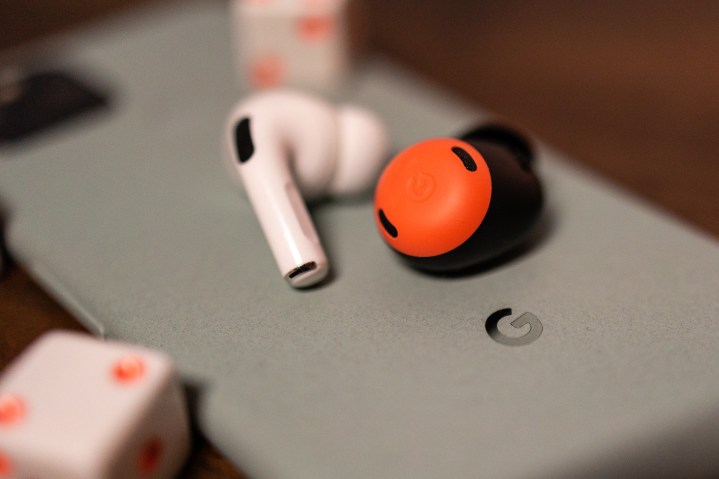
But those arcs had another benefit: they made it super easy to pluck the buds from the charging case. With the Buds Pro, it’s harder to grab them between your thumb and forefinger, but you quickly realize that putting a finger behind them (near the lid) and prying forward works every time.
Once they’re in your ear, however, all differences in design go away. The Pixel Buds Pro are very low-profile. For me, they sit almost totally flush to my outer ear. And though the outer surface is now interrupted by two microphone vents, the touch-sensing controls work exactly the same way — more on that in a moment.
Google has kept the IPX4 rating on the earbuds and even added a small amount of protection for the case itself — IPX2, which is a nice added touch in case the case is to be hit by spraying water. In the U.S., you can buy them in one of four colors: fog (light gray with a tinge of blue), charcoal (not-quite-black), lemongrass (Gatorade yellow/green), and coral (reddish-orange). You’ll see lemongrass and coral in this review.
As an evolution of the Pixel Buds design, the Buds Pro are a total success — keeping virtually everything that we liked.
Comfort, controls, and connections
Most Pixel Buds users agree that they’re very comfortable even when worn for long periods, and the Pixel Buds Pro largely continue that legacy. Because of their larger body and the way it makes contact with your concha (the outer part of your ear), you may find that your ears feel fuller, but I found no real difference in terms of wearability — the Buds Pro feel great, and they compare well to the $200 Jabra Elite 7 Pro, and the AirPods Pro. And at 0.22 ounces, they’re essentially identical in weight to the original Gen-2 buds (0.20 ounces).
Speaking of the Jabras and AirPods, Google has mimicked these earbuds by adding its own version of a fit test to the Pixel Buds app, which helps you to know if you’ve actually picked the best of the three sizes of eartips for performance as well as comfort.

If you’re among those who never found the second-gen or A-Series secure enough, you may have better luck with the Pros. On the flip-side, those with smaller conchas (the little bowl just outside your ear hole) may find them less comfortable, or even too big for a good fit.
One of the reasons the Gen 2 and A-Series feel so good is that they use a vented design that naturally relieves any air pressure difference between your ear canal and the outside world. Unfortunately, that also led to some unwanted sound creeping in, requiring an automatic volume boosting system to compensate, something it didn’t always do very well.
The Pixel Buds Pro also are vented, but it’s a new design. According to Google, “Sensors actively measure the pressure in your ear canal so the earbuds can relieve it and stay comfortable.”
Stability-wise, they’re very secure. For light exercise, they won’t budge at all and even when you start to do higher-impact work, they’re decent for a set of non-hook-style buds. As with most wireless earbuds, talking for five minutes or more will start to work them loose.
If given the choice between touch and physical controls, I tend to pick the physical ones for their superior precision and tactile feedback. But I have no complaints about the Pixel Buds Pro. Taps on the touch surface register almost every time, and you get a confirmation tone to let you know it’s working — one tone for each tap. It’s a lot more reliable than the Samsung Galaxy Buds Pro.
A long-press flips you between ANC and transparency mode, exactly the way the AirPods Pro work. I’m a huge fan of the volume adjustment which you perform with a very intuitive forward or backward swipe gesture — way better, in my opinion, than asking Siri to do it for you the way the AirPods Pro require, though if you want, Google Assistant can do that, too.
The Pixel Buds Pro are the best-sounding Pixel Buds so far.
You also can perform the usual set of commands: play/pause, track skip forward/back, and call answer/end/reject. Plus, the Pixel Buds’ signature feature — being able to summon the Google Assistant with just your voice — is still here and as helpful as ever, for all kinds of requests.
There’s no way to customize these gestures as you can on the Jabra Elite 7 Pro, but because they’re intuitive, it makes them easy to memorize. You can, however, adjust the long-press function a little if you’re on Android. You can add “off” to the ANC-on and transparency modes, and you can opt to have that work from both earbuds, or split left/right long presses between it and Google Assistant.
Either earbud can be used on its own for calls and music.

All Pixels all the time
On Android phones, pairing the Buds Pro is as simple as unlocking your phone and flipping open the lid, which immediately triggers Google’s Fast Pair feature, giving you a one-tap way of getting set up. It’s only one step more complicated on an iPhone with the usual Bluetooth menu method.
Better yet, Google has improved its Fast Pair system with a new audio-switching feature that lets you associate the Pixel Buds Pro with all of your signed-in Android devices. Those devices are then given prioritized access to the buds. A phone call on Device A can interrupt a movie playing on Device B, for instance — but a text message from device A would not. These priorities can be modified whenever you choose.
If that sounds familiar, it’s because Apple does something very similar when you use its audio and computing devices together with iCloud. It seems to work, but I could not figure out how to adjust the prioritization of sounds and devices the way Google says we should be able to do.
And, for the first time, a set of Pixel Buds supports Bluetooth Multipoint. So even if you’re not using audio switching to jump back and forth between signed-in Android devices, you can maintain a simultaneous connection to any two Bluetooth devices. It works great between Android devices, as well as with a mixed marriage between Android and iOS.
Sound quality
The Pixel Buds Pro are the best-sounding Pixel Buds so far, and I think they beat the more expensive AirPods Pro for overall fidelity. Even though Google reduced the size of the drivers from 12mm on the A-Series to 11mm for the Pro, the better passive noise isolation and excellent ANC come together to finally let you hear the full potential of these buds 100% of the time.
I’ve always admired how crisp and clear the A-Series are, and in quiet situations, you can appreciate their decent bass performance too, especially when using the Bass Boost feature. But the moment you step outside, the A-Series’ open design allows that low-end to get washed away. The Buds Pro, are effectively a closed-back version of the Gen-2/A-Series, and they do what closed-back designs do best — let you hear the full range of their performance no matter where you use them.
Despite that closed-back quality, the Pixel Buds Pro maintain and even improve on the soundstage, which is pleasingly wide and lets your favorite music escape the confines of your head, for a much more immersive experience.
As Google’s first wireless earbuds with ANC, it did a great job with the Pixel Buds Pro.
I’m a little disappointed that Google chose to omit any kind of support for high-quality (or low-latency) Bluetooth codecs. With the standard SBC and nearly-standard AAC, you’re getting perfectly decent wireless sound, but without the aptX family of codecs, Sony’s LDAC codec or any kind of low-latency mode, the Pixel Buds Pro can’t quite make the most of their potential for fans of hi-res audio, or those who like to game — something of an odd choice given that Google owns a streaming music service (YouTube Music) and a streaming gaming service (Stadia).
Google is so confident that you’ll like the way it has tuned the Pixel Buds Pro, this time you don’t even get a Bass Boost option — just the ability to toggle on and off its new Volume EQ feature, which the company claims will improve sound at lower volumes.
I tried flipping it on and off at a variety of volumes, but the difference was always super subtle even in perfectly quiet conditions. Outside, it made no difference for me at all. It’s a nice line on a marketing sheet, but probably not something you’ll actually notice.
But all that default tuning might actually be good news for any iPhone users that choose to use the Buds Pro, as Google still doesn’t offer a Pixel Buds app for iOS, so you’re stuck with whatever you get out of the box, settings-wise.
But with or without this tweak, the Pixel Buds Pro are great for a wide variety of genres of music and should satisfy all but the biggest bass-heads and the pickiest audiophiles.
One thing I couldn’t test is Google’s upcoming support for spatial audio on the Pixel Buds Pro. It’s slated to launch later this year. And while Google hasn’t said much about it, there’s every reason to expect it will mimic what Apple is doing with AirPods Pro. The inclusion of a motion-detecting accelerometer and gyroscope in each earbud should let the Pixel Buds Pro do accurate head-tracking, which is the key component that sets Apple’s spatial audio experience apart from other wireless earbuds.
Noise cancellation and transparency

As Google’s first wireless earbuds with ANC, it did a great job with the Pixel Buds Pro. When ANC mode is engaged, it provides excellent dampening of everything but the highest of frequencies. Right now, as I type, I have a fan below my desk keeping me cool during this intense summer heat, but other than feeling the air across my ankles, I have almost no awareness of it at all. Other noises, like traffic, or the din of construction are also well contained.
The Buds Pro don’t cut out quite as much high-frequency sound as the AirPods Pro, however, and their wind protection isn’t as strong: on a breezy day, or while cycling or running, some wind sound will get picked up by the ANC system. This is not uncommon, even in products that are on their second or third generation of ANC tech, like the mighty Sony WF-1000XM4, but it’s still worth being aware of.
Your callers will have no problem hearing you clearly.
If wind noise is something you think you’ll have to cope with, consider the AirPods Pro or Jabra Elite 7 Pro — they’re both superb with wind.
The only other note about ANC performance is that if you engage when there’s literally no noise for the earbuds to cancel, you may notice a very slight background hiss. If that happens, that’s a good cue to turn off ANC, which you can do in the Pixel Buds app, or using the touch controls.
Transparency on the Buds Pro is top-notch and within spitting distance of the AirPods Pro, which, despite being almost four years old, are still the best. The Pixel Buds Pro don’t quite elevate themselves to that magical feeling of wearing nothing, but you’ll have no problem at all hearing what you need and want to hear, including your own voice and those around you.
Better yet, switching between the two modes is fast and easy with a long-press on either earbud.
Call quality
Using the Pixel Buds Pro for calls or videoconferencing works very well indoors, in quiet environments and you can get decent results outdoors or in noisy spots too, but it’s something of an uneven performance.
In either case, your callers will have no problem hearing you clearly. But as outside sounds start to get louder and compete more with your voice, the noise canceling algorithms will start to smear your voice a bit, decreasing its detail and depth.
A nice touch is being able to switch into transparency mode before or during a call so you can hear your own voice as clearly as you hear your callers, which helps reduce calling fatigue.
If getting the very best calls under all conditions matters to you, the Jabra Elite 7 Pro might be a better choice, but otherwise, the Pixel Buds Pro will be just fine.
Battery life
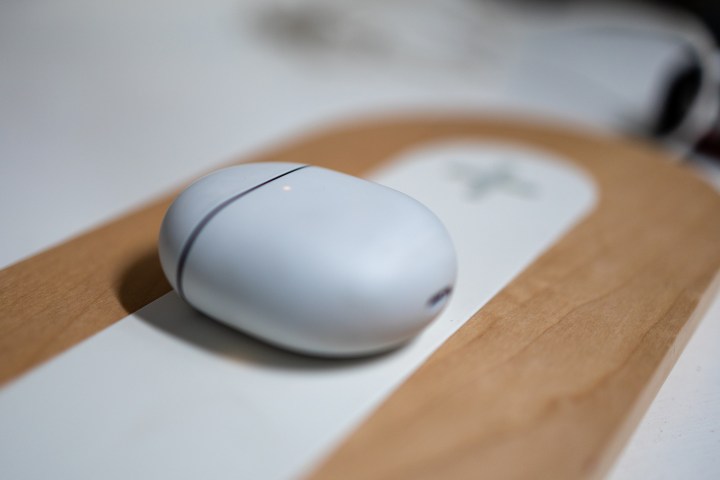
Google claims a decent seven hours per charge when you have ANC enabled and a very impressive 11 hours when it’s off. That’s better than both the AirPods Pro and the Samsung Galaxy Buds Pro. However, the case doesn’t have much of a capacity — just shy of two full charges, so you’ll only get 20 hours of total playtime with ANC on. But that jumps to 31 hours without ANC, so at least you’ve got options.
Some reports from people who received their Buds Pro earlier than expected show that not everyone is happy with the battery life they’re getting, but from my short time with these buds, Google’s numbers seem bang-on. Unfortunately, there’s no fast-charge feature, so when the buds run out, you’ll just have to wait to get them going again.
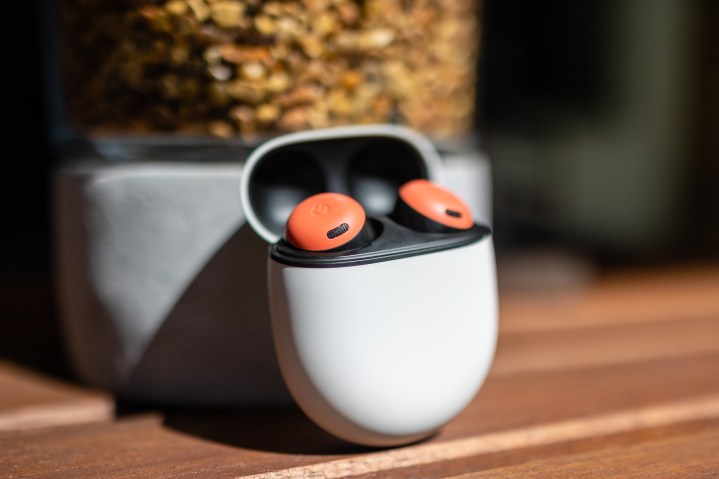
Our take
Android fans wishing they had a true AirPods Pro alternative will be thrilled with the Pixel Buds Pro. They’re comfortable, sound great, and have everything they need to become your go-to earbuds for work, play, and everything in between.
But speaking of the AirPods Pro, those buds are now three years old, and if the rumors are true, Apple will be updating them in 2023. If and when that happens, it’s quite possible they’ll launch with a slew of features that willl set a new bar for wireless audio, putting Google once again on the back foot. But for now, the Pixel Buds Pro are definitely having a moment.
Is there a better alternative?
At this price, there are a lot of fantastic choices in wireless earbuds, but the one model that prospective Pixel Buds Pro buyers should consider is Jabra’s excellent $200 Elite 7 Pro.
They are incredibly close performance-wise on things like sound quality, ANC, transparency, battery life, and wireless charging, and they even share features like Bluetooth multipoint, a fit test, and find my earbuds.
Where the Elite 7 Pro have a slight edge is robustness (with an IP57 waterproof rating versus the Buds Pro’s water-resistant IPX4), better overall call quality, and a deep set of EQ adjustments to get their sound dialed in just right.
On the other hand, the Elite 7 Pro don’t support wake-word voice assistant access (although they do give you a choice of your phone’s assistant or Amazon Alexa), and they don’t feature the Pixel Buds Pro’s upcoming spatial audio capabilities, for what that’s worth.
How long will they last?
As with most wireless earbuds, this probably comes down to their internal batteries. And with a starting life span of seven hours with ANC on, that’s not bad — you’ll still be able to get good use out of them even when they deteriorate to just 50% capacity, and there’s no telling when that will happen. If you clean them regularly and wipe away any salt and sweat once you’re done using them, I see no reason they shouldn’t last as long as any other wireless earbuds in this class.
Google backs the Pixel Buds Pro with a standard one-year warranty.
Should you buy them?
Yes. Especially if you’re an Android user, Google’s Pixel Buds Pro are an ideal audio companion that should get even better over time as Google releases new features like spatial audio. There’s nothing stopping iPhone users from using them, too, and they work great with iOS. But you just won’t get the full experience, and there’s no way to adjust their settings or update their firmware.


